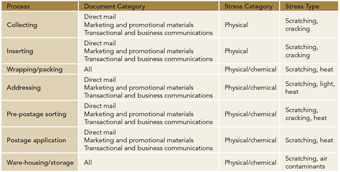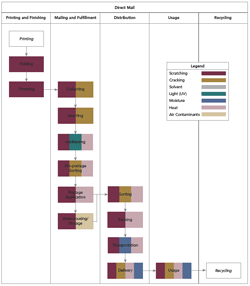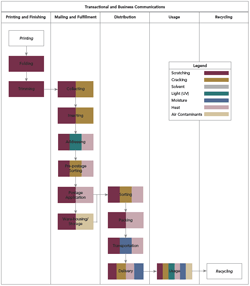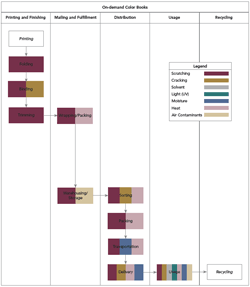by Franziska Frey
As printing technology advances, new markets and applications are developing, requiring improved document longevity and robustness. With more documents being printed digitally, it is important to understand how these documents fare in terms of permanence in various stages of their life cycle, and how they compare to conventionally printed offset documents. This month’s research monograph, a literature review entitled Permanence of Toner on Paper—Based on the Life Cycle of Documents (PICRM-2006-05), by Franziska Frey, RIT School of Print Media professor, and graduate students Henrik Holm Christensen and Nicholas DiSantis, aims to understand the life expectancy of four categories of products printed with digital processes.
These four categories are:
- Marketing and promotional materials,
- Transactional and business communications,
- Direct mail, and
- On-demand color books.
Life Cycle Terminology
Life cycle theory is a framework for describing a system in constant change. Change is described as the development that these systems undergo throughout the stages of their life cycle. A stage is therefore made up of a specific set of processes that impact the system during its development.
With this in mind, this study has been constrained to the section of the digitally printed document’s life cycle between the printing process and recycling. The stages included are:
- Printing and finishing,
- Mailing and fulfillment (mail preparation and fulfillment processes not including the actual physical distribution),
- Distribution (this includes all steps of the physical distribution),
- Usage, and
- Recycling.
In these five life cycle stages, physical and chemical stress is inflicted on the print. Since four categories of digital printed documents are dealt with, the processes within the stages of each category might differ slightly.
Factors of Stress Induction
The determining factor in the choice of digital printing technology for producing the four document categories of this study is highly dependent upon costs as well as life cycle requirements. Costs are determined from the product specification, complimentary services, and pricing strategy of the producer. With this quantity of variables it is impossible to determine the exact distribution of preferred digital printing technologies within the four document categories of this study, or to accurately predict future developments in technology and the marketplace. Therefore, inkjet, dry toner, and liquid toner printing technologies are regarded as having equal importance for producing the four document categories.
These three printing process technologies, the formulation of their colorants, and the characteristics of the substrates dedicated to them of course vary. The effect of the types of stress induced on them therefore varies as well. Inkjet is more vulnerable to certain types of stress than toner-based technologies. There is also a difference in the effects of stress between dry and liquid toner print, but due to the similarity of the technologies, the differences are smaller.
Table 1. The main types of stressors that confront the four document categories
click to view image full size
Each of the three digital processes (inkjet, dry toner and liquid toner) is dealt with individually throughout the stages of the life cycle in further analysis.
Processes in the Five Life Cycle Stages
Stage One – Printing and Finishing
Printing: Toner-based technologies. In these types of printing technologies, the most important step from the life cycle point of view is the adhering (“fixing” or “fusing”) of toner to the surface of the paper. The adhesion of the toner to the paper surface, which happens during toner fixing, is both a mechanical and chemical adhesion. The mechanical adhesion involves polymeric toner molecules penetrating into the voids of the paper surface and interlocking with the solid surface and each other. Since the strength of the mechanical adhesion is dependent upon the degree of “intermingling,” smaller polymer molecules are preferable. They tend to mingle better in the locations of the voids between fibers, and therefore create stronger bonds in these areas.
In chemical adhesion, the most applicable theory is absorption. This adhesion strength is determined primarily by the wetting of the paper from the toner’s resin. The strength of chemical adhesion is thus highly dependent on the paper’s surface energy properties for the chemical bonds to endure stress.
Printing: Inkjet printing technologies. The absorption of ink into the paper in inkjet printing is the major difference between toner-based and inkjet printing technologies. It is also the reason why abrasion resistance and adhesion strength are, in most cases, less critical issues to investigate when looking at inkjet print permanence. However, substrate properties like media pH, surface coating nature and location of the colorant have a big impact on aging properties of inkjet materials.
Finishing. The amount of stress applied to substrates in the various printing processes is minimal compared to the physical stress applied in all phases of finishing. Table 2 summarizes the stress types and categories that can occur in the printing and finishing stage.
Table 2. Summary of processes in the printing and finishing stage and their contribution of stress to printed products
click to view image full size
Stage Two – Mailing (Mail Preparation) and Fulfillment
This stage of the life cycle was defined to include mail preparation and various fulfillment processes not including the actual physical distribution of the process. Mailing and fulfillment are usually tied together because fulfillment can include mailing. Fulfillment is viewed as a value-added service which an increasing number of print services providers are offering.
Table 3. Summary of the processes in the mailing and fulfillment stage and their contribution of stress to printed products
click to view image full size
Stage Three – Physical Distribution
Distribution normally takes place after finishing, and involves a printed product being sent directly to the customer, end user, a distributor, or a warehouse. For print services providers or third parties that offer distribution services, costs, handling procedures, storage, and safety are of the utmost concern. Distribution is a key part of the digital print life cycle because, in most cases, it is the final stage before the end user.
A shift in distribution trends in the past few years has addressed some concerns of distributors. Historically, printers followed a “print and distribute” business model, that is, physically printing the product in one location and then delivering it to a remote end user. In the newer “distribute and print” business model, electronic files are distributed close to the ultimate product destination and then printed. This workflow reduces distribution stresses and is a breakthrough in cost efficiency as well as storage and safety.
However, both models still do entail stresses on the printed product, including scratching, cracking, moisture, heat, and air contaminants. These stresses are outlined in Table 4.
Table 4. Summary of the processes in the distribution stage and their contribution of stress to printed products
click to view image full size
Stage Four – Usage
Permanence issues, quality, and archivability are most critical at this stage. The definition of permanence depends on the type of product and its purpose. The principal documents focused on in this study include: marketing and promotional materials, direct mail, transactional and business communications, and on-demand color books. Based on the materials and processes used, these products vary widely in terms of user expectations about permanence.
Table 5 summarizes the processes in the usage stage and their contribution of stress to the prints.
Table 5. Summary of the processes in the usage stage and their contribution of stress to printed products
click to view image full size
Stage Five – Recycling
Recycling digitally printed materials is more complex than recycling offset lithographic materials. Traditionally, the recycling process began with a process to de-ink the printed sheets. To improve ink release, chemicals such as caustic soda, sodium silicate, hydrogen peroxide, and soap were introduced during the repulping stage of paper, making a slurry of paper fibers. However, most digitally printed products are very difficult to process this way, due to the synthetic binders used in toners. During the first stage of the process, the toner tends to break up into very large particles, some of which are too large to be removed, unlike conventional printing ink particles.
For the recycling process to be economical as well as able to produce quality recycled papers, toners must be almost completely removed from the pulp. With digital printing taking more of the market share from traditional offset lithography, this could pose a serious problem in the future. However, testing has indicated that recycled paper produced from digital printing is comparable to recycled paper produced from offset printing. New methods of efficiently recycling digitally printed products need to be explored.
Life Cycle Overview
The four document categories in this study encounter similar problems in their life cycle stages. Their situations differ, however, in the printing and finishing stage and in the mailing and fulfillment stage. Figures 1 through 4 depict the processes in the life cycle stages of each category. Note that the mailing and fulfillment stage includes mail preparation and fulfillment tasks not including the actual physical distribution. The distribution phase includes the physical distribution steps.
Figure 1. The processes in the life cycle of marketing and promotional materials
click to view image full size
Figure 2. The processes in the life cycle of direct mail
click to view image full size
Figure 3. The processes in the life cycle of transactional and business communications
click to view image full size
Figure 4. The processes in the life cycle of on-demand color books
click to view image full size
Conclusion
Digital printing has been projected to be the fastest growing print provider service over the next two years, and therefore understanding the variables that cause stress to the process is valuable. Stressors that potentially affect permanence were examined in each stage of digital printing’s life cycle:
- In the printing and finishing stage, little stress is induced by the actual printing, but physical scratching and cracking occur during finishing. During the mailing and fulfillment stages, scratching and cracking, and heat, light, and air contaminants were seen as stressors.
- Similarly, scratching, cracking, heat and moisture were identified as problems in the distribution stage.
- In the usage stage, printed materials are subjected to every type of stress found in Table 1 such as: scratching, cracking, solvents, light, humidity, heat and air contaminants.
- Lastly, recycling digitally printed products presents obstacles not encountered in the processes used for offset printed materials.
With one-to-one marketing, variable data, and print-on-demand becoming so popular, research in this area is necessary for every player in the printing industry to understand.
To read about this research in detail, download the monograph from: http://print.rit.edu/pubs/picrm200605.pdf
This article from the Printing Industry Center at RIT was originally published in the Centers affiliate-only eReview newsletter. Article Series Index.


















